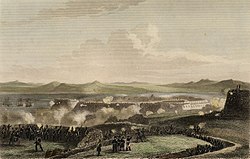History of Åland

| Part of a series on |
| Scandinavia |
|---|
 |
The history of
Geology and prehistory
Paleolithic period
Around 18,000 BC, during the
Due to the forebulge effect after the icecaps melted, the area around Åland is still rising several millimeters per year, marginally expanding the archipelago's surface.[6]
Neolithic period

Bronze Age
Many Bronze Age villages have been found on Åland. Ceramics and animal bones have been found on Kökar.[9] Signs of livestock have been found from the Bronze Age on Åland.[10]
Viking age
Dense settlements were built on
Middle Ages
The first wooden churches are built on Åland.
Swedish rule
In 1507 the Danish naval officer Søren Norby would capture Kastelholm castle.[13][8] Many battles would take place between the Danish and Swedish over Kastelholm between 1521 - 1523.[8] Gustav Vasa would make Åland a royal castle county in 1537.[13] Gustav Vasa would also establish 3 large breeding farm estates.[13] Catholicism came to an end on Åland and monasteries would be closed and the churces and monasteries had give their silver to the state.[13]
Åland would become part of the Swedish Empire and many Ålanders would be enrolled for war.[13] The postal service was given a permanent route which would go from Stockholm to Turku through Åland.[8][13]
Between 1665 and 1668 the Kastelholm witch trials would take place on Åland where over 20 women would be accused of witchcraft and would be executed.[13] The first school would be founded on Åland in the 1600s in Saltvik.[13]
During the Great Northern War many Ålanders fled west from the advancing Russians.[13] The Battle of Grengam would take place in Åland during the Great Northern war on 7 August 1720.
During the Napoleonic Wars, the Russians would occupy Åland in 1808. The Treaty of Fredrikshamn would be signed by Russia and Sweden. Finland and Åland are ceded to Russia.[16][8][13]
Russian rule

In 1829 the Fortress of Bomarsund begins construction.
As the result of abundant Anopheles claviger mosquitoes, malaria was endemic in Åland for at least 150 years, with severe outbreaks being recorded in the 18th century, and in 1853 and 1862.[19]
A telegraph cable is in use from
World War I breaks out and Russia begins building fortifications on Åland.[8][21] Fortifications would be built on Saggö, Börkö, Sålis, Frebbenby, Mellantrop, Kungsö, Korsö, Herrö, Storklobb och Kökar.[21] Many Ålanders wanted to join Sweden.[8][22] A referendum would be held on Åland and 95% was willing to join Sweden.[23] Finland would declare independence from Russia in 1917 and had sent troops to take over Åland. Sweden would send troops to Åland on 13 February 1918. The Finnish Whites would take Boxö and Saggö. Finnish reds would land on Åland on 17 February 1918. The Finnish Whites and Reds would fight over Godby and the Whites would win. Germans would land on Åland on 28 February 1918.
Chronology up to 1921
- 1918: The islanders internationally plead to reunite with Sweden.
- 1919: Sweden brings the question before the Paris Peace Conference on 18 March but the islands remain part of Finland.[18]
- 1921: The Åland convention re-establishes the demilitarised status of the islands.
See also
- History of Finland
- Invasion of Åland
- Battle of Bomarsund
- Kastelholm Castle
- Åland Convention
 Wikimedia Atlas of Åland
Wikimedia Atlas of Åland
References
- ^ a b c d Early history. (2014, September 25). Visit Åland. https://www.visitaland.com/en/good-to-know/history/early-history/ Retrieved 25 August 2021
- ^ NASA. (2014, June 4). Åland Islands. Earthobservatory.Nasa.Gov. https://earthobservatory.nasa.gov/images/52174/aland-islands Retrieved 25 August 2021.
- ^ Mörner, N. A. (1995). The Baltic Ice Lake-Yoldia Sea transition. Quaternary International, 27, 95-98.
- ^ Stone Age Åland. Retrieved 29 August 2006. (in Swedish)
- ^ Andrén, T., Björck, S., Andrén, E., Conley, D., Zillén, L., & Anjar, J. (2011). The development of the Baltic Sea Basin during the last 130 ka. In The Baltic Sea Basin (pp. 75-97). Springer, Berlin, Heidelberg.
- ^ December 2006, Anne-Maj Lahdenperä Pöyry Environment Oy, Working Report 2006-111, Literature Review on Future Development of the Baltic Sea and Recommendations for Safety Modelling
- ^ Götherström, A., Stenbäck, N., & Storå, J. (2002). The Jettböle middle Neolithic site on the Åland Islands–human remains, ancient DNA and pottery. European Journal of Archaeology, 5(1), 42-69.
- ^ ISBN 9518946000.
- ^ "early history". visitaland.
- ^ "forntiden". visitaland.
- ^ historia/ "ålands historia". visitaland.
{{cite web}}: Check|url=value (help) - ^ "Permenenta utställningar". visitaland.
- ^ ISBN 951894671X.
- ISBN 9789525614749.
- ^ a b "Historia kring slottet". Kastelholms slott.
- Prothero, G.W. (1920). The Åland Islands. Great Britain. Foreign Office. Historical Section. p. 9.
- ISBN 952996403X.
- ^ Prothero, G.W. (1920). The Åland Islands. Great Britain. Foreign Office. Historical Section. pp. 9–10.
- Prothero, G.W. (1920). The Åland Islands. Great Britain. Foreign Office. Historical Section. p. 3.
- Prothero, G.W. (1920). The Åland Islands. Great Britain. Foreign Office. Historical Section. p. 6.
- ^ a b Gustavsson, Kenneth (2003). Sevärt Batterier. Ålands landskapsstyrelse.
- ISBN 978-952-49838-3-9.
- ^ Lindqvist, Herman (29 March 2014). "Då höll Åland på att bli en del av Sverige". Aftonbladet (in Swedish). Retrieved 7 January 2017.
- This article incorporates text from a publication now in the public domain: Chisholm, Hugh, ed. (1911). "Åland Islands". Encyclopædia Britannica. Vol. 1 (11th ed.). Cambridge University Press. p. 469.
 This article incorporates text from this source, which is in the Prothero, G.W. (1920). The Åland Islands. Great Britain. Foreign Office. Historical Section. pp. 9–10.
This article incorporates text from this source, which is in the Prothero, G.W. (1920). The Åland Islands. Great Britain. Foreign Office. Historical Section. pp. 9–10.
External links
 Media related to History of Åland at Wikimedia Commons
Media related to History of Åland at Wikimedia Commons

